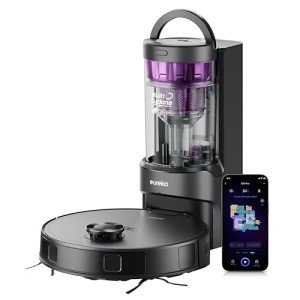Robotic Vacuum Cleaner Commercial: Revolutionizing Home Cleaning
In recent years, robotic vacuum have actually emerged as a cutting-edge innovation in home cleaning technology. With their automated functions and intelligent navigation systems, these devices have transformed the way people maintain tidiness in their home. This post intends to explore the functionalities, advantages, and future of robotic vacuum cleaners, showcasing their role in modern households.
Overview of Robotic Vacuum Cleaners
Robotic vacuum are autonomous devices developed to perform cleaning tasks without requiring manual intervention. Using advanced sensing units, expert system, and a host of other innovations, these appliances can browse throughout a home, getting dirt, dust, and particles from numerous surface areas while preventing barriers.
Key Features of Robotic Vacuum Cleaners
Robotic vacuum come geared up with a variety of functions that improve their performance:
| Feature | Description |
|---|---|
| Navigation Systems | Utilize various innovations like laser mapping and cameras to navigate efficiently |
| Automatic Charging | Return to docking stations to recharge when battery levels are low |
| Scheduling | Users can program cleaning schedules for particular times and days |
| Smart Home Integration | Get in touch with other smart gadgets for boosted performance |
| Several Cleaning Modes | Adapt cleaning styles based on the type of surface area being cleaned up |
| App Control | Allow users to manage settings, get notices, and start/stop cleaning from another location |
Advantages of Robotic Vacuum Cleaners
- Time-Saving: With robotic vacuums, users can allocate their time to other essential tasks while the device manages the cleaning. This convenience is a significant selling point for busy homes.
- Consistent Cleaning: Robotic vacuum can carry out day-to-day cleaning jobs, ensuring that dirt and dust do not collect, leading to a healthier indoor environment.
- Energy Efficiency: Most robotic vacuums promote energy effectiveness, often using less power than conventional vacuum, thus decreasing electrical power costs.
- Smart Technology: With features like real-time mapping, users can keep track of the cleaning process. Some advanced designs even provide data on cleansings, such as locations covered and the amount of dirt recorded.
- Ease of access: Robotic vacuums are especially helpful for the elderly or people with movement problems, simplifying the cleaning procedure without the requirement for physical effort.
Downsides of Robotic Vacuum Cleaners
Regardless of their many advantages, robotic vacuum also have constraints:
- Limited Suction Power: While they work for daily maintenance, they might not be as effective as conventional vacuums for deep cleaning.
- Obstacle Navigation: Some robotic models may fight with complex designs, stairs, or high-pile carpets.
- Battery Life: Most robotic vacuums come with minimal battery life, indicating bigger homes may require numerous charging cycles to cover all areas.
- Cost: High-quality models can be expensive compared to standard vacuum cleaners.
Selecting the Right Robotic Vacuum Cleaner
With various alternatives offered in the market, picking the right robotic vacuum can be a challenging task. Here are some elements to consider:
- Home Size: Larger homes may require designs with longer battery life and bigger dust bins.
- Surface Types: Consider a design that works well on particular surfaces in your home, such as wood, carpet, or tiles.
- Smart Features: Evaluate the level of smart combination if you choose remote operation and monitoring via a mobile phone app.
- Brand Reputation: Opt for credible brands known for dependable products and good client service.
Recommended Robotic Vacuum Cleaners
| Brand name | Model | Secret Features | Price Range |
|---|---|---|---|
| iRobot | Roomba s9+ | Advanced mapping, effective suction | ₤ 949-₤ 1,099 |
| Roborock | Roborock S7 | Sonic mopping, adjustable cleaning paths | ₤ 649-₤ 749 |
| Eufy | RoboVac 30C | Affordable, strong suction, app control | ₤ 250-₤ 300 |
| Neato | D7 Connected | Special D-shape design, zone cleaning software | ₤ 599-₤ 700 |
| Shark | IQ Robot | Self-emptying base, smart mapping | ₤ 599-₤ 699 |
Future of Robotic Vacuum Cleaners
As technology advances, the future of robotic vacuum looks promising. The integration of AI and machine learning systems is anticipated to improve navigation capabilities. Emerging trends include:
- Enhanced Interaction: Future designs might include integrated voice assistants, enabling users to provide cleaning commands through voice.
- Enhanced Sensors: Enhanced sensors might cause better challenge acknowledgment, allowing the vacuum to work more efficiently in messy areas.
- Multi-Functionality: Future robotic vacuums might manage extra tasks, such as mopping or window cleaning, consolidating numerous cleaning jobs into one device.
Frequently Asked Questions About Robotic Vacuum Cleaners
1. Just how much do robotic vacuum cleaners usually cost?
The price can vary widely, varying from ₤ 200 to over ₤ 1,000, depending on functions and brand.
2. Can robotic vacuum tidy carpets effectively?
Yes, many contemporary robotic vacuum are created with powerful suction systems that can clean numerous carpet types.
3. Do smart vacuum cleaner need much upkeep?
Upkeep is relatively low; nevertheless, users need to routinely clean the filters, empty dust bins, and periodically examine the brushes for obstructions.
4. For how long does a robotic vacuum operate on a single charge?
Many robotic vacuums can run for about 60 to 120 minutes, depending on the model and cleaning conditions.
5. Can I schedule my robotic vacuum to clean up when I'm not home?
Yes, the majority of robotic vacuum come with scheduling functions that permit users to set particular times for cleaning.
Robotic vacuum cleaners are not just gadgets; they represent a substantial evolution in home cleaning technology. By making cleaning jobs easier and more effective, they enable users to enjoy a cleaner living environment with very little effort. As innovation progresses, it is likely that these devices will end up being even more sophisticated, paving the way for a smarter, clutter-free future.

